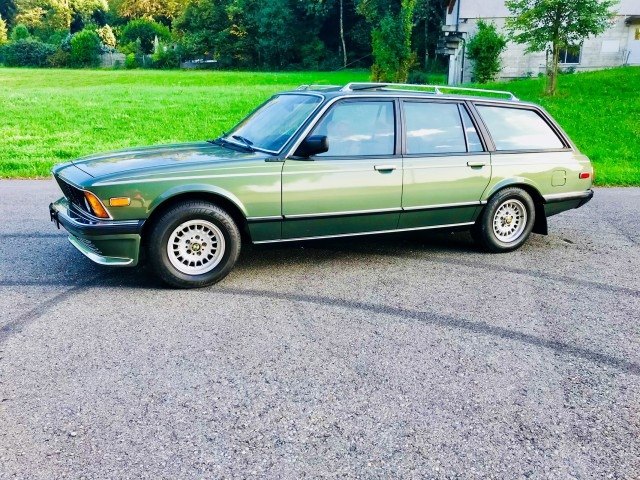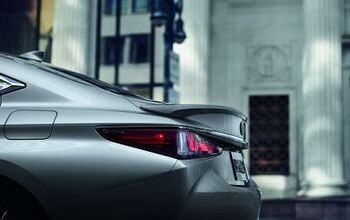Rare Rides: The Incredibly Rare 1981 BMW 735i Touring

Today’s Rare Ride is one of just a handful of custom-built 7 Series wagons, created by a coachbuilder who wanted flagship BMW luxury with additional cargo carrying capabilities.
Come along as we check out this large BMW wagon.
The E23 7 Series was the first of its name when it replaced the smaller “New Six” E3 for the 1978 model year. Compared to its predecessor the E23 took a much more modern form; one which remains instantly recognizable as a BMW to this day. Its design was developed by then-director of design Paul Bracq, a man who shaped many BMW and Mercedes-Benz sedans over the years.
Long before the long-wheelbase and V12 era, BMW made do with a selection of inline-six engines. In the 7 Series, they ranged in displacement from 2.5 to 3.2 liters in naturally aspirated guise, and 3.2 to 3.4 liters if turbocharged. Base models with smaller engines had carburetors through the late Seventies and were later available only to government agencies or by special order. Transmissions on offer included three- and four-speed automatics, as well as four- and five-speed manuals. The E23 was the first BMW to implement Bosch Motronic fuel injection, ABS, and to be offered with an airbag (1985).
In the United States, being the luxurious and discerning place it was, only higher-end 7 Series cars were imported. Models in the US were limited to the 733, 735, and the ultimate L7 fully-loaded model. Complying with regulation meant US-bound 7 Series cars had different sealed beam headlamps, big bumpers, and lower engine compression ratios than their European brethren.
Up until the late Seventies, German manufacturers hadn’t bothered to create large family wagons, as that was not their vibe. The disinterest opened up a small market for coachbuilders to modify sedans into wagons for the well-heeled, which is where today’s 7 Series comes along. The sedan you see here was transformed into a luxury wagon by a company called Euler, which spent most of its time creating different versions of the early 7 Series.
Turning the sedan into a wagon required a completely reworked rear end. In addition to its unique hatch, rear doors were redesigned to be larger and more upright and lost their Hoffmeister kink. Lots of rear glass matched well with the new squared-off cargo area, which was lined in luxurious parchment colored carpet. The exterior utility look was completed with some roof rails straight off a contemporary Mercedes-Benz wagon. It also sported an Alpina front bumper for a more aggressive stance.
Euler made only a few of its special 7 Series wagons, eventually giving up the ghost as the OEMs themselves offered larger wagon options for consumers (albeit not a 7 Series). The E23 remained in production through 1986 before it was replaced by the E32, a generation with which you all are undoubtedly much more familiar.
Today’s Rare Ride has quite a history. It was imported to the US shortly after its creation and was federalized thereafter. At some point, it was put in storage where its condition degraded generally. Languishing and with its value much depleted, it was subject to an estate sale in 2010. At that point, it migrated back to its homeland with its new owner and was refreshed and generally restored within the last few years. It’s now for sale in Switzerland for $136,000.
H/t to Jay Ramey at Autoweek, who drove and profile this BMW in 2016.
[Images: seller]

Interested in lots of cars and their various historical contexts. Started writing articles for TTAC in late 2016, when my first posts were QOTDs. From there I started a few new series like Rare Rides, Buy/Drive/Burn, Abandoned History, and most recently Rare Rides Icons. Operating from a home base in Cincinnati, Ohio, a relative auto journalist dead zone. Many of my articles are prompted by something I'll see on social media that sparks my interest and causes me to research. Finding articles and information from the early days of the internet and beyond that covers the little details lost to time: trim packages, color and wheel choices, interior fabrics. Beyond those, I'm fascinated by automotive industry experiments, both failures and successes. Lately I've taken an interest in AI, and generating "what if" type images for car models long dead. Reincarnating a modern Toyota Paseo, Lincoln Mark IX, or Isuzu Trooper through a text prompt is fun. Fun to post them on Twitter too, and watch people overreact. To that end, the social media I use most is Twitter, @CoreyLewis86. I also contribute pieces for Forbes Wheels and Forbes Home.
More by Corey Lewis
Latest Car Reviews
Read moreLatest Product Reviews
Read moreRecent Comments
- Mikey My youngest girl ( now 48 ) dated a guy that had a Beretta with a stick shift. The Dude liked Beer and weed. too much for my liking..I borrowed my buddy's stick shift Chevette and give her short course on driving a manual .. I told her if the new BF has more than 2 beer or any weed ..You drive ...I don't care how many times you stall it, or or of you smoke the clutch . She caught on quite well ,and owned a succession of stick shift vehicles...An as an added bonus she dumped the guy.
- Blueice "Due to regulation/govt backing, China is poised to dominate BEV/battery production, just as they do solar panel production, drone production, etc.Taiwan dominates production of certain types of chips due to regulation/govt backing and we saw how precarious such a situation is (especially with the PRC increasingly becoming aggressive towards Taiwan).That's why regulation/govt backing is aiming to build up local chip manufacturing."BD2, these businesses and or industries are not free market enterprises, buttcorporatist, bent on destroying their competitors with the use of governmentalunits to create monopolies. How safe are world consumers when the preponderance of computer chipsare made in one jurisdiction. Do you what Red China controlling any industry ??And it is well known, concentrated markets control leads to higher prices to end users.
- Master Baiter I told my wife that rather than buying my 13YO son a car when he turns 16, we'd be better off just having him take Lyft everywhere he needs to go. She laughed off the idea, but between the cost of insurance and an extra vehicle, I'd wager that Lyft would be a cheaper option, and safer for the kid as well.
- Master Baiter Toyota and Honda have sufficient brand equity and manufacturing expertise that they could switch to producing EVs if and when they determine it's necessary based on market realities. If you know how to build cars, then designing one around an EV drive train is trivial for a company the size of Toyota or Honda. By waiting it out, these companies can take advantage of supply chains being developed around batteries and electric motors, while avoiding short term losses like Ford is experiencing. Regarding hybrids, personally I don't do enough city driving to warrant the expense and complexity of a system essentially designed to recover braking energy.
- Urlik You missed the point. The Feds haven’t changed child labor laws so it is still illegal under Federal law. No state has changed their law so that it goes against a Federal child labor hazardous order like working in a slaughter house either.







































Comments
Join the conversation
4th picture, center console: Q: How much real space can we take up with just an e-brake lever and A/T shift selector? A: *This* much.
Really? Crank windows? If you said this was a '71, that seems about right. Milking the old carcasses became he shtick of German carmakers. Yeah I know. If you have to explain, I wouldn't understand.